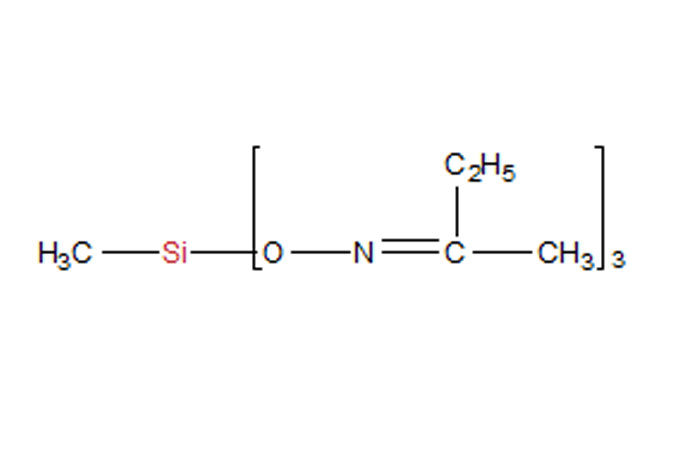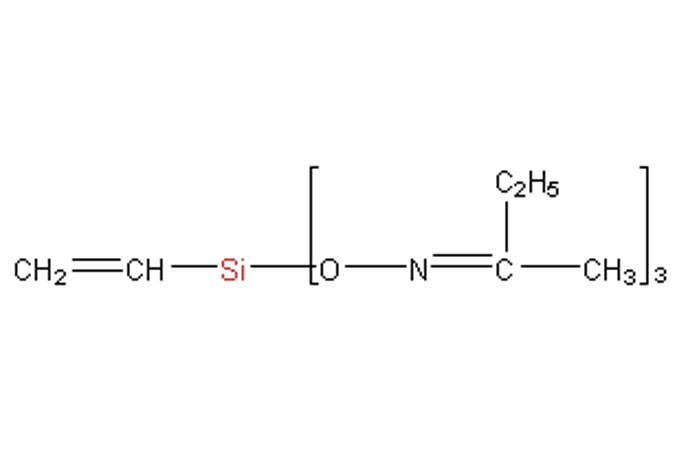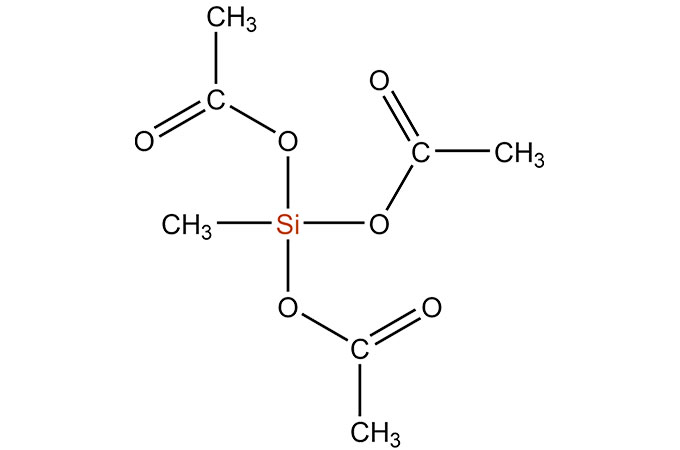Silane crosslinking process: the organofunctional group of the silane can react, and bond to, the polymer backbone. Residual moisture activates the silane’s alkoxy groups to the active silanol form which react with each other, liberating moisture and forming siloxane bonds between the polymers. The resulting Si-O-Si crosslink is extremely durable, offering excellent weather, UV, temperature, chemical and moisture resistance.
The cross-linking agent used in RTV silicone systems consists of a species that can be represented as R-Si-X3 (typically used in one-component systems) or Si-X4 (typically used in two-component systems). The R is an organic group such as methyl, ethyl, or vinyl, phenyl, and the X is a moisture hydrolysable group. A simplified cure mechanism for a one-component RTV silicone adhesive sealant is showing below.
Figure A: Reaction of crosslinker with polymer ends:
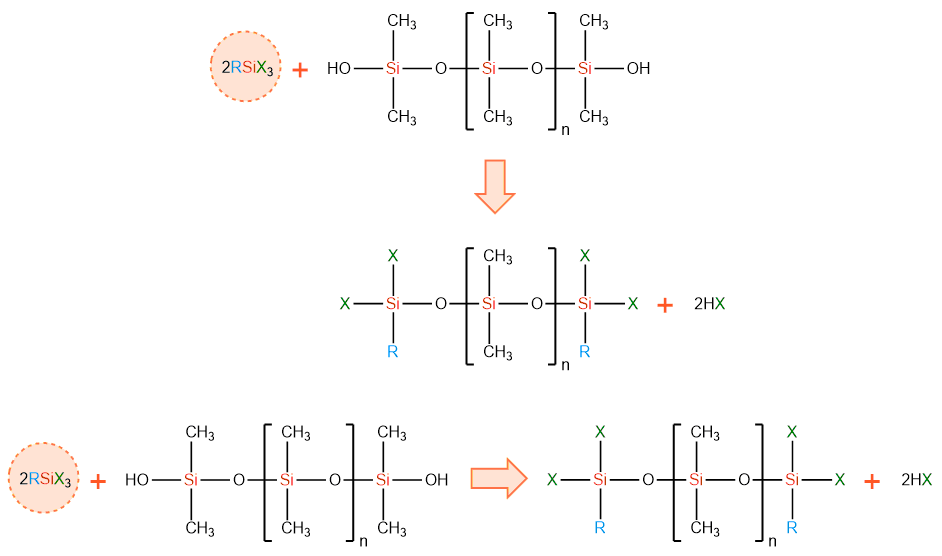
Figure B: Reaction of crosslinker-capped polymer end with moisture:
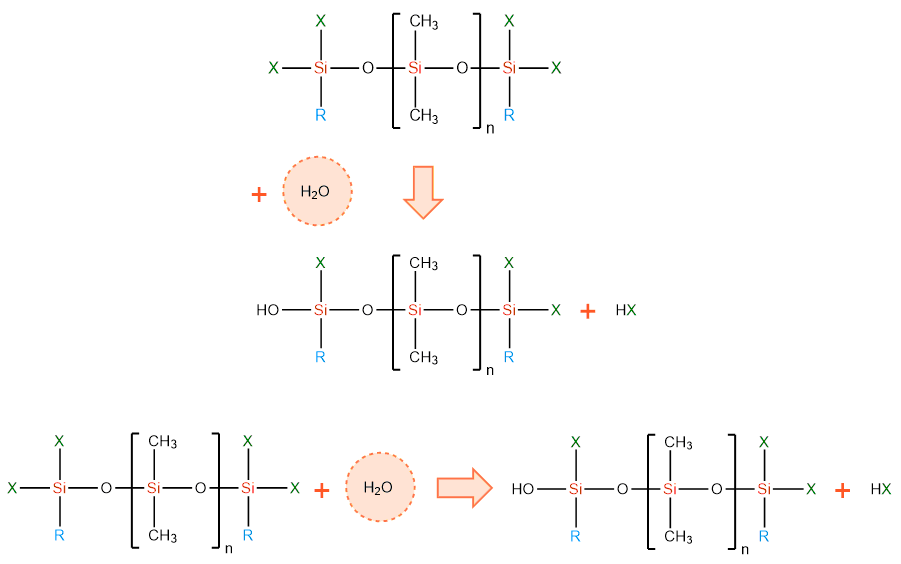
Figure C: Reaction of resultant polymer end with another polymer:
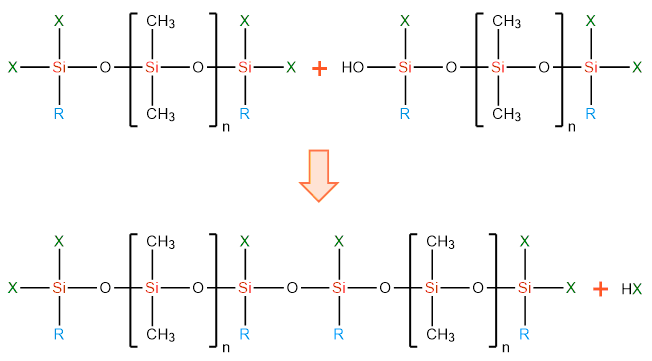
Repeated hydrolysis and reaction of resultant polymer end groups lead to full cure with the elimination of HX as a by-product of the condensation reaction.
The acetoxy cure system is the most common RTV system, and it has been used for the longest period of time. However, the by-product is acetic acid, and this could be corrosive to metal substrates or undesirable because of the odor. The alkoxy cure systems produce a by-product that is noncorrosive and has an unobjectionable odor. The acetoxy, alkoxy, and oxime chemistries are all prevalent today. The characteristic of these cure systems are summarized in the table below:
Characteristics of Various RTV silicone Cure Systems
RTV cure system | Characteristics |
Acetoxy | Relatively fast cure time and short tack-free time. Good adhesion. |
Alkoxy | Longer talk-free time and slower cure than acetoxy. By-product produced is noncorrosive and without objectionable odor. Adhesion is not as good as acetoxy. |
Oxime | Low corrosion behavior but somewhat longer tack-free and cure times than acetoxy or alkoxy. |
In one-component systems, the crosslinker is added to the filled silicone polymer and immediately reacts with the polymer as indicated in figure A. The reaction results in the formation of two moisture-hydrolyzable reactive sites at each end of every polymer chain. Once reacted in such a manner, the product is ready for packaging. It must be kept away from moisture or moisture vapor to avoid the subsequent curing steps and to provide long shelf life.
Once applied and exposed to ambient moisture, two adjacent polymer chains will react through the hydrolyzable reactive sites as show in figure B. The cross-linking will continue until all cross-link sites have been completely consumed. The resulting molecule is a highly cross-linked network with good elasticity.
The cure of an RTV two-component silicone sealant occurs in a similar manner. Most often an alkoxy silane crosslinking agent and a catalyst are packaged together leaving the siloxane as the second part. A reactive metal catalyst such as dibutyltin dilaurate is generally used to begin the curing reaction. The components must, of course, be kept dry to provide adequate shelf life. Once the two components are mixed, the hydrolysis reaction begins. After this occurs, the cross-linking reaction may be accelerated by exposure to slightly elevated temperatures.
Cross-linking of either one-component or two-component RTV silicone systems at room temperature may be accelerated by the use of catalysts at low levels. The catalyst is usually a tin octoate or dibutyltin dilaurate. The rate of crosslinking is a function of catalyst concentration and its chemical nature. Catalyzed systems are especially useful in forming a quick-dry skin that is often desirable in an outdoor applications where the weather and elements cannot be controlled.
SiSiB has been developing and producing crosslinkers and coupling agents for the sealant industry for over twenty-five years, supplying world markets with a successful range of innovative products.
Acetoxy Silane Crosslinker | Oximine Silane Crosslinker | Alkoxy Silane Crosslinker |
SiSiB® PC7930 MTA | SiSiB® PC7130 MOS | SiSiB® PC5131 MTMS |
SiSiB® PC7950 ETA | SiSiB® PC7220 DMOS | SiSiB® PC5132 MTES |
SiSiB® PC7960 VTA | SiSiB® PC7500 VOS | SiSiB® PC5420 TEOS |
SiSiB® PC7970 PTA | SiSiB® PC7400 TOS | SiSiB® PC5424 TEOS-40 |
SiSiB® PM2080 | SiSiB® PC7600 POS | SiSiB® PC5430 TPOS |
SiSiB® PM3070 | SiSiB® PC7133 Methyl MIBKO Silane | SiSiB® PC6110 VTMO |
SiSiB® PM7030 | SiSiB® PC7530 Vinyl MIBKO Silane | SiSiB® PC6151 Enoxy |
SiSiB® EM7030 | SiSiB® PC7410 Tetra MIBKO silane | SiSiB® PC8151 Enoxy |
| SiSiB® PC7131 Methyl Acetoxime Silane |
|
| SiSiB® PC7531 Vinyl Acetoxime Silane |
|
| SiSiB® PC7160 Methyl 2-PO Silane |
|
| SiSiB® PC7560 Vinyl 2-PO Silane |
|
| SiSiB® MT9010 / MT8515 / MT8020 |
|
| SiSiB® MV6733 / MV8020 |
|
| SiSiB® VT5545 / VT6535 / VT8020 / VT8515 |
|
 English
English 日本語
日本語 한국어
한국어 français
français Deutsch
Deutsch Español
Español italiano
italiano русский
русский português
português العربية
العربية tiếng việt
tiếng việt


